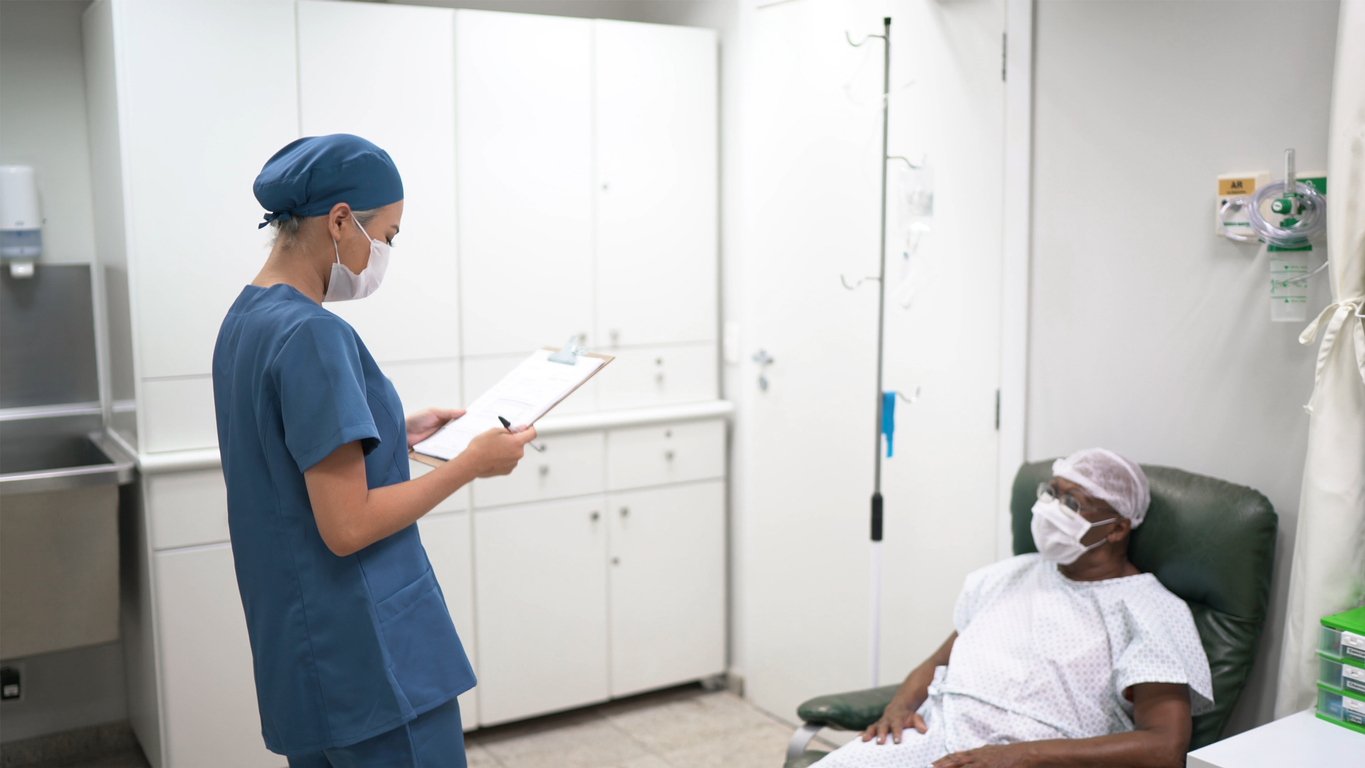Ovarian cancer comprises 4 per cent of all invasive cancers diagnosed in Ireland, ranking sixth among female cancers. It affects women of a median age between 65 and 69 years. The majority of cancers present late at stage III or IV due to the insidious nature of the malignancy, with its tendency to provoke symptoms only when at advanced stages and this is reflected in its five-year survival of 35 per cent.
<h3><strong>Ovarian cancer biology</strong></h3>
Ovarian cancer is far from being a single disease. It is subdivided into at least five different histopathological subtypes that have very different risk factors, natural history, preferential sites of metastasis, molecular composition and somatic DNA abnormalities. While standard treatment for most types of ovarian cancer remains cytoreductive surgery and platinum-based chemotherapy, responses to this and further treatment strategies vary substantially, according to the specific histology and biology. Currently, ovarian cancer is divided into epithelial and non-epithelial subtypes. Epithelial ovarian cancer (EOC) is further classified into high-grade serous, low-grade serous, endometrioid, clear cell and mucinous. Non-epithelial ovarian cancers constitute 10 per cent of the total incidence and will not be discussed in this review. They include germ cell tumours and sex cord stromal tumours.
As our knowledge base of underlying cancer mutations progresses, we see different ‘signatures’ among these five subtypes, which are starting to aid further tailoring of therapy. These differing genetic aberrations and key mutations that ‘drive’ cancer development are depicted in Figure 1 and have led to current and planned EOC trials that are mutation-specific.
<h3><strong>Surgical cytoreduction</strong></h3>
The surgical outcome was confirmed as a significant prognostic factor for survival in advanced EOC by pooling trial data in 2009 (European AGO-OVAR and GINECO groups). Patients without any residual macroscopic disease had a median survival of 99.1 months. This was significantly reduced if there was residual tumour left behind. If this tumour amounted to 1-to-10mm, the median patient survival was 36.2 months and if residual disease was greater than 10mm total, it was only 29.6 months. This substantial survival discrepancy dependent upon surgical resection has driven ultra-debulking radical surgical techniques, including peritonectomy and omentectomy, bowel resections and diaphragmatic stripping, to achieve the goal of maximal cytoreduction.
The precise timing of this surgery remains uncertain. While initially, primary surgery followed by chemotherapy was standard of care, the alternative of giving chemotherapy first (usually three cycles) followed by surgery and a further three chemotherapy cycles takes place frequently. This has the advantage of shrinking the tumour and potentially making surgery easier and less extensive, as well as identifying the chemotherapy-resistant (primary refractory) cancers at the outset.
A number of trials (CHORUS, JGOG 0602 and EORTC 55971) have not demonstrated any difference between primary versus interval surgery as regards patient survival, with better postoperative complication rates and more complete tumour resection rates with up-front chemotherapy. Nonetheless, there remains controversy over the precise superior course, with strong criticisms of the above trials, in particular the study patient selection, as well as surgical morbidity and mortality rates higher than expected. These criticisms have cast shadows upon the results. The TRUST trial (NCT02828618, Trial on Radical Upfront Surgical Therapy) aims to answer this controversial question by randomising patients to primary debulking surgery or neoadjuvant chemotherapy and interval debulking surgery in preapproved surgical centres to standardise for surgical skill, expertise and postoperative patient management.
<h3><strong>Chemotherapy agents</strong></h3>
Chemotherapy in the first-line setting is carboplatin and paclitaxel as standard of care the world over. Ovarian cancer tends to be particularly sensitive to platinum chemotherapy agents such as carboplatin and indeed, single-agent carboplatin in patients who have other comorbidities or reduced physical fitness is a viable alternative to the combination regimen to shrink the tumour, alleviate cancer-related symptoms and impact patient survival. In general, although by no means guaranteed, a good response can be expected from initial chemotherapy treatment, however the disease frequently relapses. If that re-occurrence is after six months from completion of the initial regimen, carboplatin and paclitaxel are often re-trialled. Other chemotherapeutic agents of benefit in this disease subtype include liposomal doxorubicin (Caelyx), gemcitabine (Gemzar), etoposide, vinorelbine, trabectedin (Yondelis) and topotecan (Hycamtin), although the latter four are uncommonly used. These agents can be combined with carboplatin or used on their own, depending on whether a patient is considered sensitive or resistant to platinum agents. As noted, platinum sensitivity is defined as the time of disease progression from completion of carboplatin and a six-month cut-off is used, although in reality platinums can be re-challenged successfully in patients who obtain a lesser treatment-free interval.
Unlike other malignancies, ovarian cancer continues to derive benefit from chemotherapy during the natural history of the disease, with evidence of benefit up to the fifth line of chemotherapy. A typical clinical course of ovarian cancer treatment is illustrated in Figure 2, where the disease burden, by radiology or reflected by the classical tumour marker, Ca125, is graphed against time and the impact of chemotherapy and surgery can be seen, as well as the development of platinum resistance.
<h3><strong>Targeting angiogenesis</strong></h3>
Angiogenesis is the formation of new vessels from existing vasculature and is critical to the development of ascites and metastasis in ovarian cancer. Local imbalance of this biological process in cancer promotes vascularisation and vascular leakage. There are different methods of targeting angiogenesis in cancer. One of these is using large monoclonal antibodies against the vascular endothelial growth factor (VEGF), the most well-known of which is bevacizumab that binds to VEGF-A. Alternatively, there are many smaller oral tyrosine kinase inhibitors (TKI) that are active against the VEGF receptors, as well as a range of proteins involved in the angiogenic process. Examples of these TKIs include cediranib, trebananib, nintedanib and pazopanib, among others.
Bevacizumab has been trialled extensively in ovarian cancer in numerous settings. Overall, it has consistently improved progression-free survival, defined as the time before the cancer starts growing again following the completion of chemotherapy, and it is particularly helpful against cases with ascites. Unfortunately it has failed to statistically and consistently impact upon overall survival (OCEANS and AURELIA), except in patients considered to have a high-risk of relapse in the ICON7 study. It is approved, licensed and frequently used to improve time to disease relapse, although there are concerns over the ongoing costs of such therapy when no clear survival advantage has been shown.
The small molecule inhibitors have had a similar impact, improving time to progression without a substantial impact on patient survival (a selection of trials include TRINOVA, ICON6, AGO-OVAR 12, AGO-OVAR 16 and MITO-11) and their place in the future management of this disease is still uncertain.
<h3><strong>Inherited ovarian cancer and DNA damage repair</strong></h3>
About one-fifth of ovarian cancers are inherited. The greatest risk factor for the development of ovarian cancer includes germline mutations in genes involved in DNA damage repair processes, the most well-known of which are the tumour suppressor genes BRCA1 and BRCA2. Approximately 65-to-85 per cent of inherited ovarian cancers are caused by the BRCA mutation (BRCAmut) tumour-suppressor genes. The lifetime risk of ovarian cancer with BRCA1 mutation carriers is 40-to-50 per cent and 20-to-30 per cent for BRCA2 mutation carriers. Patients with germline mutations in the BRCA1/2 genes are generally diagnosed at a younger age, have high-grade epithelial, usually serous, carcinomas and those who respond tend to have a longer and better clinical outcome.
Ovarian cancer is also a feature of Lynch syndrome (hereditary nonpolyposis coli (HNPCC)), which is characterised by deficiencies of the DNA mismatch repair (MMR) genes, also involved in the DNA damage repair process. The cumulative risk of ovarian cancer in Lynch syndrome families is at least 12 per cent, although endometrial cancers and colon cancers are the more common cancers developed in this population. A further inherited disease is Li Fraumeni syndrome, which is a genetic loss of the tumour suppressor gene TP53 and can also give rise to ovarian cancers, among a myriad of other malignancies.
The ovarian cancer itself can also develop and carry a mutation in BRCA1/2 in an estimated 5-to-7 per cent. Additionally, other genes involved in the DNA damage repair pathways are found to be dysfunctional in EOC. These include loss of the aforementioned MMR genes, silencing of BRCA1 via methylation, as well as mutations in PALB2, CHEK2, RAD52 and BRIP1, to name a few. These abnormal variants are often the driving force underlying tumour development and progression and are thought to be involved in up to half of all EOC. The presence of these DNA damage repair deficiencies prevents the cell from appropriately repairing DNA mistakes and errors, and instead uses more error-prone pathways that result in the development of further multiple mutations that ultimately can result in tumour progression, distant metastasis, resistance to treatment and potential response to alternative therapeutic strategies such as immunotherapy, as discussed below.
These DNA damage-repair genes have been and continue to be extensively studied to identify ways of targeting them with anti-cancer agents. This has led to the development of Poly (ADP-ribose) polymerase (PARP) inhibitors. These oral tablets use a concept known as ‘synthetic lethality’, whereby inhibiting PARP, that repairs single strand DNA breaks, the cancer cell with pre-existing deficits in DNA damage repair processes, such as a BRCA1/2mut (ie, homologous recombination (HR) deficiency) is forced to use error-prone DNA repair pathways instead and thus leads to additional mutations and/or cell death (Figure 3). Examples of these PARP inhibitors include olaparib, niraparib, rucaparib and talazoparib. The success of PARP inhibitors in BRCAmut patients is clear. Using olaparib as maintenance therapy after chemotherapy in the SOLO2 trial extended progression-free survival from 5.5 months to 19.1 months; rucaparib in the same indication in ARIEL3 advanced progression-free survival from 5.4 months in non-BRCAmut to 16.6 months in BRCAmut; and niraparib in the NOVA trial saw progression-free survival intervals of 21 months in BRCAmut and 5.5 months in non-BRCAmut patients. However, as previously mentioned and further explored in the ARIEL3 and NOVA trials, there are further groups of non-BRCAmut patients with dysfunctions in other DNA damage repair genes who also gain substantial benefits from PARP inhibitors. To date, the precise identification of these subgroups has not been fully established and the current biomarkers to identify PARP inhibitor-sensitive patients remain suboptimal.
Resistance to PARP inhibitors is a problem, as with many targeted therapies. It is unknown whom, when and why resistance will develop, with some patients from the initial PARP inhibitor trial, Study 19, still deriving significant tumour response from these agents over six years later. PARP inhibitor resistance can be multifactorial but often involves reversion mutations of BRCA1/2, which result in restoration of the gene function and corresponding lack of further efficacy of PARP inhibitors.
Interesting work from Joyce Liu et al identified the combination of an antiangiogenic (cediranib) with a PARP inhibitor (olaparib) having a better than expected result in BRCA wild-type (non-BRCAmut) patients, suggesting a potential for this strategy in non-BRCAmut patients going forward. Non-BRCAmut patients on the combination had an improved survival of 23.7 months, compared with 5.7 months with olaparib alone. The underlying science hypothesises that hypoxia driven by the antiangiogenic agent might enhance sensitivity to PARP inhibitors by causing genomic instability and dysfunction of the DNA repair pathways, simulating a BRCAmut–type genotype by artificial conditions. The NRG-GY005 (NCT02502266) trial is ongoing, comparing cediranib with olaparib versus non-platinum chemotherapy in recurrent platinum-resistant ovarian cancer, irrespective of BRCAmut status, is ongoing.
<h3><strong>Immunotherapy in EOC</strong></h3>
Immunotherapy has been used to significantly advance survival in lung cancer, melanoma and bladder cancer, among other malignancies.
In EOC, however, response rates have been around 20 per cent; disappointing, although suggestive of a cohort of patients who may benefit from the administration of these agents that act by stimulating the host’s immune system to fight cancer. There is growing evidence to suggest that this immunotherapy-sensitive subgroup includes patients with deficiencies of DNA damage repair pathways, such as BRCA1 and BRCA2, as well as others discussed in this article.
This subgroup has an already dysfunctional DNA repair system and is thus prone to developing further mutations. These genetically unstable tumours tend to have a high mutational burden and these malignancies tend to be more responsive to immunotherapy, as the high neoantigen load enhances recognition and priming of the patient’s immune system. To better enhance immunotherapy responses in non-BRCAmut patients, combination strategies might be the key to unlocking sensitivity, with antiangiogenics and PARP inhibitors logical partners due to minimal overlapping toxicity and the potential to increase the number of patients who would gain a clinical benefit. Current trials such as ATALANTE are exploring bevacizumab with or without the PD-1 inhibitor atezolizumab (NCT02891824), rucaparib (PARP inhibitor) plus atezolizumab (NCT03101280), or niraparib (PARP inhibitor) plus pembrolizumab (PD-L1 inhibitor) (TOPACIO, NCT02657889).
<h3><strong>The older ovarian cancer patient</strong></h3>
As ovarian cancer affects a substantial number of older patients, considered to be 70 years and over, there have been multiple analyses looking at the elderly ovarian cancer population and their tolerability of these advances discussed above. While evidence for the use of these agents in older women is limited, there appears to be no signal for any difference in efficacy. Studies generally confirm that the elderly patient is treated more cautiously than their younger counterparts, with statistically less optimal multimodal therapy completed, despite undergoing treatment in specialised cancer centres. This impacts upon patient survival. Some of this reluctance has come from retrospective studies that suggested older patients have greater morbidity and mortality. Trials such as MITO-5 and MITO-7 have looked at chemotherapy in the older population, as compared with those under 70 years old. They have trialled different chemotherapy doses to address the toxicity issue in the older population to enhance their overall outcome and survival and found few significant differences between the two groups. PARP inhibitors also appear similarly tolerable in the elderly population, with no concerning signals from subgroup analysis of the larger PARP inhibitor trials, although this is early data.
ROSiA looked at side-effects in older patients aged over 70 years who received antiangiogenic therapy with bevacizumab. It noted no difference in treatment efficacy according to age but more serious adverse events in the older population, with more hypertension (41 per cent vs 22 per cent) and thromboembolic events (7.5 per cent vs 2 per cent) and more discontinuations for unacceptable toxicity (22.3 per cent vs 16.6 per cent). OTILIA also looked at the impact of age on safety and efficacy of bevacizumab-containing therapy in patients with EOC. It noted a comparable progression-free and overall survival, as well as similar serious adverse events and complications of special interest in this drug type (proteinuria, hypertension and GI perforation), irrespective of age.
Recently there has been a trend to use geriatric frailty indices to identify older patients who may be more likely to develop toxicity from cancer treatment strategies. Clearly, there are significant variations in health at a specific elder age, and using frailty indices to measure overall wellbeing and physical fitness are more likely to be predictive of side-effects, rather than the age number itself. Scales used include the Modified Frailty Index score and frailty deficit index.
<h3><strong>Future targeting strategies</strong></h3>
The future of ovarian cancer therapy is bright, with a wide variety of targets being explored. Antibody drug conjugates with tissue factor (TF) and AXL as targeted receptors are showing early promise in phase 1 trials. Targeted therapies against the folate receptor (FR) when known to be present results in durable tumour responses in heavily pre-treated, high-grade serous cancers. While the FR-alpha antibody farletuzumab has been disappointing in its results to date, a newer agent, ONX0801, was recently presented by Banerji et al and early-phase results are promising. Additionally, the use of a variety of hormonal agents in cancers that express the oestrogen receptor as well as other players in the endocrine pathways can significantly slow time to disease progression and impact patient survival. These are a multitude of novel compounds and are being developed to parallel our increasing understanding of the biology underlying EOC (Figure 4).
<h3><strong>Conclusion</strong></h3>
The progress of EOC, an umbrella term for a variety of genetically and phenotypically different malignancies, has improved substantially over the past two decades, with extensive multidisciplinary involvement and expertise. This has resulted in (1) highly-trained, centralised gynae-oncology surgeons embarking upon radical debulking operations; (2) improved chemotherapy regimens with a growing understanding of the underlying complex biology of this disease; and (3) exciting novel agents targeting angiogenesis, cell surface receptors, DNA damage repair pathways (PARP inhibitors), as well as the potential for immunotherapy, either alone or in combination (Figure 4). These and future treatment strategies will continue to propel this disease subtype forward to advance patients’ survival.
<strong>References on request </strong>












Leave a Reply
You must be logged in to post a comment.